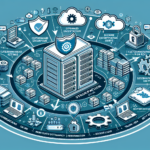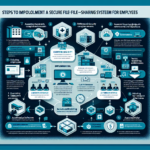Securing data on shared storage systems is critical to prevent unauthorized access, data loss, or corruption. Here are key best practices and strategies to ensure robust security:
1. Implement Access Control Policies
- Role-Based Access Control (RBAC): Assign permissions based on roles to ensure users only access the data they need.
- Least Privilege Principle: Limit access rights to the minimum required for users or services to perform their tasks.
- Access Auditing: Regularly review and audit access permissions to prevent privilege creep.
2. Enable Encryption
- At-Rest Encryption: Ensure data stored on shared storage is encrypted using strong algorithms (e.g., AES-256).
- In-Transit Encryption: Use protocols like TLS or HTTPS to encrypt data transfers between users and storage systems.
- Hardware-Level Encryption: Leverage encryption features in storage hardware or security appliances where applicable.
3. Use Authentication and Authorization
- Strong Passwords: Enforce a strong password policy with complexity requirements and regular expiration.
- Multi-Factor Authentication (MFA): Add an extra layer of security by implementing MFA for access to storage systems.
- Centralized Identity Management: Use tools like Active Directory (AD), LDAP, or IAM solutions for unified and secure authentication.
4. Isolate Sensitive Data
- Data Segmentation: Store sensitive data in separate volumes, shares, or partitions, and apply stricter access controls.
- Network Segmentation: Use VLANs or firewalls to isolate shared storage systems from other parts of the network to minimize exposure.
5. Implement Backup and Recovery Plans
- Regular Backups: Schedule frequent backups to ensure data is recoverable in case of corruption or ransomware attacks.
- Offsite Storage: Store backups in remote locations or cloud services for added redundancy.
- Immutable Backups: Use write-once-read-many (WORM) storage for critical backups to prevent unauthorized changes.
6. Monitor and Audit Activity
- Log Management: Enable logging for access attempts, changes, and file operations to track unauthorized activities.
- Anomaly Detection: Use tools or AI-driven systems to detect unusual behavior or potential breaches.
- Compliance Reporting: Regularly audit logs to ensure compliance with regulations like GDPR, HIPAA, or PCI-DSS.
7. Apply Regular Updates and Patches
- Firmware Updates: Keep storage system firmware updated to fix vulnerabilities.
- OS and Software Patching: Regularly update the operating systems and management software used for shared storage.
- Security Configuration: Harden the storage system configuration by disabling unnecessary services and ports.
8. Protect Against Malware and Ransomware
- Endpoint Security: Ensure devices accessing shared storage have antivirus and anti-malware software installed.
- Ransomware Protection: Use storage systems with built-in ransomware detection and mitigation features.
- Snapshots: Regularly take snapshots of shared storage to quickly roll back in case of ransomware attacks.
9. Leverage Advanced Storage Security Features
- Data Deduplication and Compression: Ensure these features are secured to prevent data manipulation or exposure.
- Access Quotas: Set quotas for storage usage to prevent abuse or accidental over-consumption.
- Object Storage Policies: If using object storage, enforce bucket policies and ACLs (access control lists) for fine-grained control.
10. Educate Users
- Training: Conduct regular security awareness training for employees who access shared storage systems.
- Phishing Awareness: Teach users how to spot phishing attempts and handle suspicious emails or links.
- Acceptable Use Policy: Enforce policies outlining proper usage of shared storage systems.
11. Use Advanced Security Tools
- Data Loss Prevention (DLP): Deploy DLP tools to monitor, classify, and protect sensitive data on shared storage.
- Encryption Key Management: Use a secure key management system to manage encryption keys effectively.
- Storage Security Software: Leverage third-party solutions for added layers of security.
12. Regularly Test Security Measures
- Penetration Testing: Conduct periodic security assessments to identify vulnerabilities in shared storage.
- Simulated Attacks: Test storage system defenses against common attack vectors like brute force or malware.
- Disaster Recovery Tests: Validate that backups and recovery processes function correctly.
By following these practices, you can minimize risks and ensure that data stored on shared systems is protected against unauthorized access, corruption, or loss. Security measures should be tailored to the criticality of the data and compliance requirements specific to your organization.
How do I secure data on shared storage systems?



